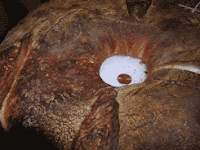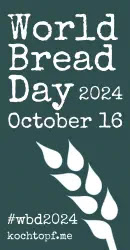The February Daring Bakers challenge was hosted by Mary (The Sour Dough) and Sara (I Like to Cook). After several sweet dessert events, this one featured bread, and not just any bread, but classic French bread à la Julia Child. There were 16 pages of instructions! Well, that’s why we are Daring Bakers – no challenge is too difficult! Well, maybe.
Now, I love making bread, so I felt I was up for the challenge. How hard could it be?
Glad you asked.
Round One
After reading the instructions multiple times, I measured and kneaded and proofed. The dough was on the soft, wet side, so that required patience and care. All in all, pretty straightforward. Until I got to the shaping part. This required using a linen towel, saturated with flour, on which I was to place my shaped dough, upside down, for the final rise. After which, I was to flip the risen dough onto a wooden board, slash the tops, then slide those suckers onto a baking sheet. Right. Want to see a grown woman cry? When I flipped, the bread decided to stay firmly on the linen towel. To add insult to injury, they all deflated. So, I stood there, debating my choices: wad everything up and throw it all away or try to salvage something? Oh, it took every nano-ounce of self-control I possessed to keep going. I scraped the deflated bread-like objects off the towel, re-shaped them, and place them on a parchment-lined baking sheet. They were now on their fourth rise, and the oven was good and hot. After about an hour, I decided to bake them. I tried to slash the tops, I really did, but the dough was so soft that not even my sharpest knife would work. I just smeared the dough, deflating them yet again. Last straw, so into the oven they went.

Well, they look nice enough and they actually tasted good. But, I must have been the only one who failed at bread-flipping. Sad but true.
Should I make this recipe again? Am I going to let a French bread recipe defeat me?
No. I’m a Daring Baker after all. Onward.Round Two
A week later, after some mental recovery, I decided to try again. Only this time, there would be no flour-saturated towel or bread flipping. All proceeded as per plan, and the loaves were shaped and placed directly on the parchment-lined baking sheet. I also changed the water-spritzing times, doing it every 30 seconds for the first few minutes, rather than at 3-minute intervals. By the time the bread has been in the oven for a few minutes, any further steam has minimal effect. The loaves turned out fine, although the baguette-like ones were fairly flat. The taste was wonderful in spite of the shape.


Should I make this recipe again, and try to play with the shape? Oh, why not.
Round Three (yesterday)
Ok. I can breeze through this recipe now with my eyes closed. I’m still not flipping and the dough is still so gooey that my knife just won’t cut it, but other than that all went well. Except for one thing. I forgot to play with the shaping bit. I remembered when I was about to slide them into the oven. By this time, I decided it didn’t matter, so into the oven they went. And, I was able to wait the requisite two hours before eating because of a phone call and a dog walk.


It’s delicious bread, to be sure, with a nice texture. And, even though it takes all day, it’s not that much trouble. But that flipping bit gives me nightmares. But. Must Not Try Again. ; )
If you want to experience an exciting bread-making adventure, you can find the recipe here. And, be sure to visit the 600-plus Daring Bakers and read about their successes.





























